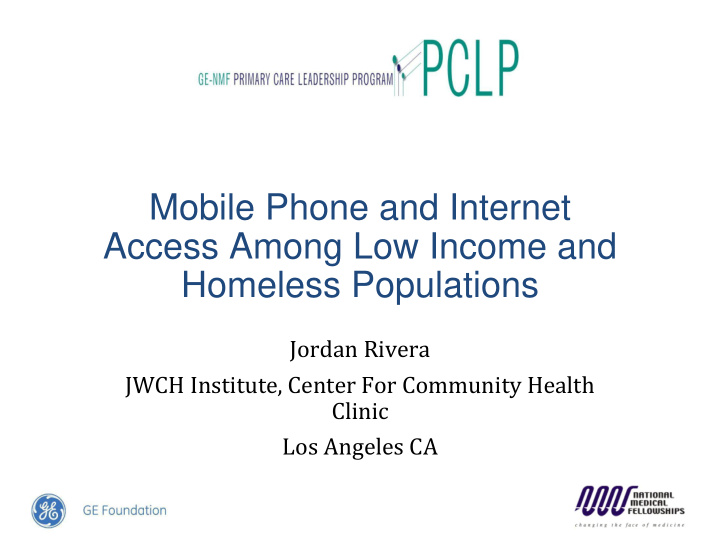



Mobile Phone and Internet Access Among Low Income and Homeless Populations Jordan Rivera JWCH Institute, Center For Community Health Clinic Los Angeles CA
Introduction • Expansion of the Internet • Meaningful Use: Portal System • It is necessary to assess the technological capabilities, barriers, and willingness within a population to use a patient portal in order to determine the best approach towards implementation.
Background • In the span of a year, more than 190,000 men, women, and children experience homelessness throughout Los Angeles County. • Despite their needs, access to healthcare services can be challenging for homeless individuals for a variety of reasons including social and psychological barriers, and other prioritized necessities such as food and shelter competing with healthcare • Studies have shown that mobile phone ownership by homeless individuals ranged from 44%- 62%, computer access and use ranged from 47%-55%, and internet use from 10%-84% • Two specific aims (SA) have been constructed: First, to develop a validated questionnaire in multiple languages to fit the demographics of the target population. Second, to distribute the questionnaire to the patients at CCH.
Methodology • In order to carry out SA1, literature was reviewed on the topic of technological use in healthcare and a 28 question questionnaire was constructed and validated, collecting information on demographic variables, housing, technological accessibility and preferred methods of communication between patient and health care professional. • In order to carry out SA2, over the course of 5 weeks the paper questionnaires written in either English or Spanish depending on the patient’s preferred spoken language, were distributed. • A random number generator was utilized, choosing numbers corresponding to chairs in the waiting room between 1 and 25. The data was collected and tallied.
Results • 100 total participants • 82% of patients had access to a cell phone • 61% reported that they know how to access the internet from their cell phones.
Results
Discussion • 5 Patients have access to a computer but no cellphone, 19 have a cellphone but no access to a computer, and 13 have neither a cellphone or access to a computer • Questions raised • Is language a barrier that needs to be overcome? • Are there a lack of technological skills due to age? • Further points of research • Longer and more extensive study • Greater population ( reach out to more clinics)
Recommendations • First and foremost. Have the clinical workers reach out and collect emails. There are still 48% of patients with emails, and that is not reflected currently within the system. • Collaborate with transitional housing programs on skid row. • Hands-On Technology lessons • Mobile Platform
Conclusion • Adding a patient portal at this time is going to require creative strategies to obtain email addresses • Language, age, and computer skills may be potential barriers to implementation • Given that there are many unmet health needs and medical complexities, Implementing a patient portal may be a critical step in improving health outcomes for vulnerable populations.
Acknowledgements Paul Gregerson, M.D. MBA Matthew Ho, PhD. Charles Drew University Center for Community Health and JWCH Institute
Recommend
More recommend